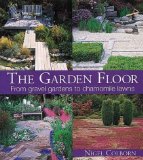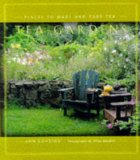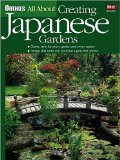| A time-tested design for a solitary (or intimate) garden retreat. |
| ABOUT US START IDEAS DO LESS USEFUL PLANTS PROJECTS VIEWS RESOURCES TOPICS |
|
|
|||
But although this secluded area provides a relaxing place to settle down with a pot of tea and a book, it's not just a place for solitary pleasure. The characteristics that make it comfortable and interesting for one person also make it attractive for groups of people and various activities. My family uses the tea garden for eating meals outdoors, observing animals, chats with friends, and small parties. Here are the key elements I've adapted from a Japanese-style tea garden to make my own garden retreat. You can use the same elements to make a cozy retreat in your garden. Sheltered Sitting Area In traditional tea gardens, the main sitting area is placed inside a small building with minimal furnishings. The building provides a feeling of enclosure and shelter from the elements.My "tea house" is a screen tent on a bed of wood chips, and inside I've arranged a couple of comfortable canvas chairs that I use regularly and a couple of benches to accommodate groups. Screen covers all the walls and doors, so the interior is relatively free of mosquitoes, bees, and other insects. The roof keeps out the intense summer sun, rain, falling leaves, and bird droppings. Planting beds surround the tent, and paths lead off from it in several directions. I often do my reading and writing work there, pausing between tasks to watch plants and animals. Since the screen shields us from their view, the animals visit the birdbath just outside the tent even when half-a-dozen people are chatting inside. Though it enjoys an extensive view, the screen tent feels like a mostly private sitting area. A solid wooden fence surrounds the garden, and buildings and trees block views from the windows of tall neighboring houses. Since we don't often sit in the garden during winter, it doesn't matter much that many of these trees are deciduous; still, I've learned to appreciate those that leaf out early in spring and hang onto their leaves late into autumn, since they extend our season of privacy. I've planted a few evergreens that will eventually provide year-round privacy, but they'll likely need a decade or more of growth to do it. Controlled Visual Focus Traditional Japanese-style tea houses allow only a chosen view of the garden, and the view is meticulously maintained to minimize distraction and promote contemplation.My screen tent doesn't block any views, and since my garden is a work in progress, a glance around often reveals unfinished chores. I have found that it's easier for me to ignore those chores and focus on what I'm reading or writing if there are attention-catching objects inside the tent. On the low coffee table in the tent, I've placed a wooden bowl full of textured objects—shards of amethyst, lava, and limestone; river rock pebbles; driftwood; a champagne cork—that invite closer examination of their contrasting surfaces. Letting my eyes or fingers roam over these appealing objects refreshes my powers of concentration without bringing to mind any chores or plans, because the objects (unlike the garden) are complete. Even if I'm conversing with other people, I feel that having appealing objects within the tent subtly contributes to our comfort and pleasure. If the only focus were outside the tent, we might be less able to focus on each other. Providing focal points within the tent as well as outside it makes it easier for people to choose where to focus, and to move their attention smoothly from inside to outside and back. A good way to draw attention back inside the tent is to decorate the floor. My tent sits on a square bed of wood chips, and I've decorated the floor with a single row of stone pavers around the outer edge of the bed and another row around the central table. A pattern of concentric circles (or squares, in this case) subtly leads the eye back into an area. For more ideas about materials and design of garden floors, check out Nigel Colborn's colorful, useful book Garden Floor: From Gravel Gardens to Camomile Lawns Another way of drawing attention back into a space is to provide a focus in the center of the space. A low coffee table anchors the center of my tent, a magnificent slab of limestone resting on two other chunks of rock. It's sturdy enough to put one's feet up and large enough to hold a tray or two of snacks, and the weathered surface offers ten times the textural interest of any other table. (To a rock lover like me, this is the ideal table.) These focal points—bowl of objects, decorated floor, and central table—partly compensate for the extensive view my tea house tent provides, since they can be used to promote meditation in the same way that the tea garden uses a controlled view. Winding Path The typical Japanese-style tea house is arrived at via a winding path. In her book Tea Gardens: Places to Make and Take TeaMy back garden is only twenty feet by forty feet, but the tea house tent sits at the opposite end from the back door, and the path to it changes from urban, civilized sidewalk to semi-civilized rock patio and then to a looser, wilder trail of rocks. This change in materials has a subtle but definite effect; the way to the tea house feels longer than it actually is, and the progressively more natural path helps people shed some of their "street attitude" en route. So far as I know, the tent is also free of wicked spirits. Condensed Local Landscape The plantings and rock or water features in a Japanese tea garden attempt to express in miniature a part of the Japanese landscape. Raked gravel may suggest an ocean, a planting bed might form an island in the center, and a group of carefully placed rocks could indicate a mountain.To be true to the spirit of the Japanese tea garden, my own garden must relate to my local landscape. I've surrounded the tent with plantings that suggest native prairie, oak savannah, rocky outcrops, and Great Lakes area woodland. For a good discussion of different styles of Japanese gardens, including tea gardens, and how to adapt their principles to American landscapes and lifestyles, see the book Creating Japanese Gardens |
"A Tea Garden" is part of a series on lawnless landscapes. See others :
 Garden Floor: From Gravel Gardens to Camomile Lawns  Tea Gardens: Places to Make and Take Tea  Creating Japanese Gardens |
||
|
Thanks for visiting http://www.LessLawn.com! All site contents © 2001-2013 Evelyn J. Hadden, except where noted. All rights reserved. |